
Hayling Island is an island off the south coast of England, in the borough of Havant in the county of Hampshire, east of Portsmouth.
The Atrebates were a Belgic tribe of the Iron Age and the Roman period, originally dwelling in the Artois region.
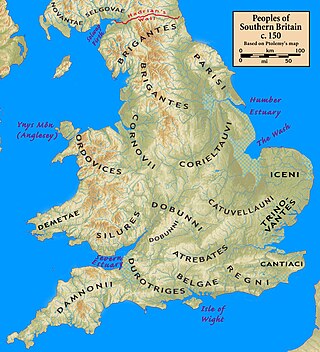
The Regini tribal heartland was located at Noviomagus Reginorum The tribe was surrounded on the west by the Belgae, on the north by the Atrebates, and on the east by the Cantiaci. The Regni tribe seemed to have settled in the Manhood Peninsula within the Chichester Dykes and the southern part of the Selsey Peninsula, with the vast and nearly impenetrable Weald Forest forming a natural border.
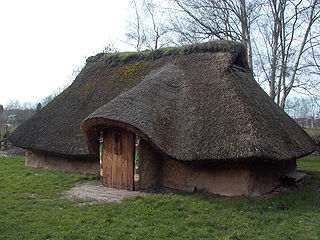
The Menapii were a Belgic tribe dwelling near the North Sea, around present-day Cassel, during the Iron Age and the Roman period.
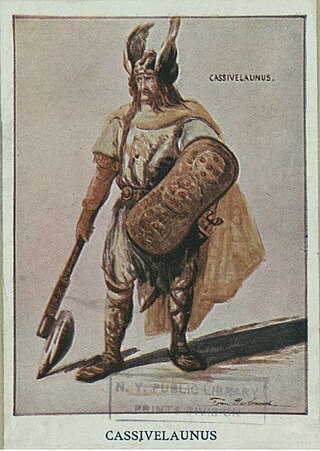
Cassivellaunus was a historical British military leader who led the defence against Julius Caesar's second expedition to Britain in 54 BC. He led an alliance of tribes against Roman forces, but eventually surrendered after his location was revealed to Julius Caesar by defeated Britons.
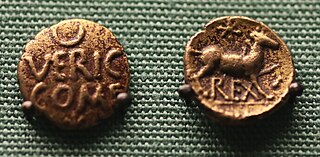
Verica was a British client king of the Roman Empire in the years preceding the Claudian invasion of 43 AD.

Tincomarus was a king of the Iron Age Belgic tribe of the Atrebates who lived in southern central Britain shortly before the Roman invasion. His name was previously reconstructed as Tincommius, based on abbreviated coin legends and a damaged mention in Augustus's Res Gestae, but since 1996 coins have been discovered which give his full name.
Gaius Volusenus Quadratus was a distinguished military officer of the Roman Republic. He served under Julius Caesar for ten years, during the Gallic Wars and the civil war of the 40s. Caesar praised him for his strategic sense and courageous integrity.

Commius was a king of the Belgic nation of the Atrebates, initially in Gaul, then in Britain, in the 1st century BC.

The Roman client kingdoms in Britain were native tribes which chose to align themselves with the Roman Empire because they saw it as the best option for self-preservation or for protection from other hostile tribes. Alternatively, the Romans created some client kingdoms when they felt influence without direct rule was desirable. Client kingdoms were ruled by client kings. In Latin these kings were referred to as rex sociusque et amicus, which translates to "king, ally, and friend". The type of relationships between client kingdoms and Rome was reliant on the individual circumstances in each kingdom.
Eppillus was the name of a Roman client king of the Atrebates tribe of the British Iron Age. He appears to have ruled part of the territory that had previously been held by Commius, the Gaulish former ally of Julius Caesar who fled to Britain following the uprising of Vercingetorix, or possibly of his son. Eppillus is not mentioned in any historical sources. Coins bearing his name also bear the inscription COMMI.FILI which is generally read as Commios filius indicating at least a claim to be Commius's son.

The Morini were a Belgic coastal tribe dwelling in the modern Pas de Calais region, around present-day Boulogne-sur-Mer, during the Iron Age and the Roman period.

Pentatominae is a subfamily of Pentatomidae, a family of shield bugs. This subfamily is the largest one within the Pentatomidae, having 4937 species classified in 938 genera. Species in this subfamily are phytophages and several of them are considered agricultural pests. Some invasive pentatomines such as Halyomorpha halys and Bagrada hilaris have been considered household pests. Higher systematics of the group have been revised by Rider et al.
Vercassivellaunus was a Gaulish commander of the Arverni who led a relief force to assist Vercingetorix, who was besieged and low on supplies, in the Battle of Alesia. Caesar refers to him as a cousin of Vercingetorix. He encamped with his generals to the west of the battle. According to Caesar, their names were Commius, Viridomarus and Eporedorix. Sedullos, chief of the Lemovices, joined Vercassivellaunus with 10,000 of his own men and was killed at the battle. According to Caesar's "Commentarii de Bello Gallico", Vercassivellaunus was taken prisoner. It is speculated that he was subsequently strangled to death with the other Gaulish prisoners of war as part of the Triumph in which Caesar celebrated his victory over the Gauls.
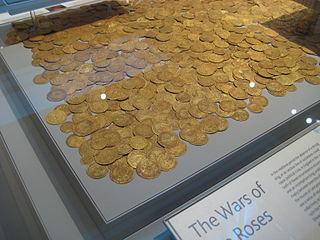
The British Museum Department of Coins and Medals is a department of the British Museum involving the collection, research and exhibition of numismatics, and comprising the largest library of numismatic artefacts in the United Kingdom, including almost one million coins, medals, tokens and other related objects. The collection spans the history of coinage from its origins in the 7th century BC to the present day, and is representative of both Eastern and Western numismatic traditions.
Events from the prehistory of Britain.

Ambiorix's revolt was an episode during the Gallic Wars between 54 and 53 BC in which the Eburones tribe, under its leader, Ambiorix, rebelled against the Roman Republic.

The Winchester Hoard is a hoard of Iron Age gold found in a field in the Winchester area of Hampshire, England, in 2000, by a retired florist and amateur metal detectorist, Kevan Halls. It was declared treasure and valued at £350,000—the highest reward granted under the Treasure Act 1996 at that time.
Diemeniini is a tribe of shield bugs in the subfamily of Pentatominae.

Commius elegans is a species of shield bug in the tribe Diemeniini found in eastern Australia.











